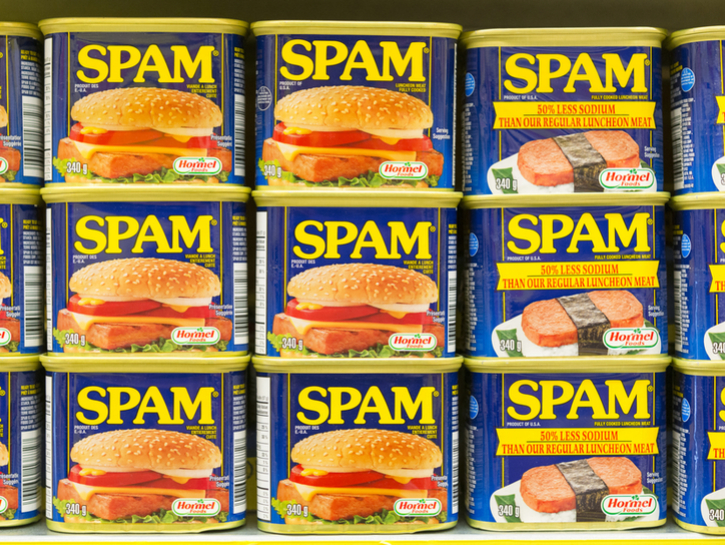The pre-cooked, canned confection known as Spam was developed by Hormel Foods Corporation in the 1930s. It began to make history as soon as it started to hit shelves, and throughout the decades it has gone on to have a colorful history of being served on battlefields to being celebrated in pop culture. Here are some surprising facts about America’s most popular canned meat:
Spam Only Has Six Ingredients
Spam is the most popular canned meat brand in the world, and it is made up of only six-ingredients: pork, water, salt, potato starch, sugar and sodium nitrate. It might not sound that appealing today, but the Great Depression was crippling America during its release in 1937, which might explain its creation and appeal.

jreika/Shutterstock
How Spam Got Its Name
After George A. Hormel had perfected his product, the entrepreneur was faced with a struggle of finding the perfect name for his creation. There are many myths as to how Spam got its name — some claim it’s an acronym for “Scientifically Processed Animal Matter,” some say it’s mash of the words “spice” and “ham,” and some insist it stands for “Shoulder of Pork And Ham.” Hormel’s official story is that to settle on a title for the product, a product-naming contest was held at a New Year’s Eve party in 1936. Broadway actor Kenneth Daigneau was the lucky winner with the word “Spam,” for which he was paid $100 — and although it’s unclear why that strange word caught Hormel’s eye, the brand’s title is now one of the famous in the world.
Spam Was A Major Food Source In WWII
Despite early Spam ads that were trying to sell the product to housewives as an easy-prep meal, Spam developed a strong presence overseas during World War II. Due to its long shelf life, Spam was used as rations for soldiers and fed countries whose food supplies were being drained due to the war. The product was first shipped to Great Britain and the Soviet Union, where soldiers and civilians alike ate the canned meat like candy.
America’s entrance into the war expanded Spam consumers to American soldiers, yet as they were forced to consume the product for every meal, the troops quickly grew tired of the uber-processed product. Dwight D. Eisenhower even wrote a letter to Hormel Foods in the 1960s for the company’s 75th anniversary about his experience with Spam as a World War II soldier: “I ate my share of SPAM along with millions of soldiers. I’ll even confess a few unkind remarks about it. As former Commander In Chief, I officially forgive you your only sin: sending us so much of it.”

jabiru/Shutterstock
Spam And The ‘Hormel Girls’ Campaign
Soldiers of war were the target consumers of Spam, and after the war ended Hormel needed a way to keep his business alive and thriving. So the company recruited a group of servicewomen to tour America in 25 white Chevrolets and promote Spam. They would go on to be known as the “Hormel Girls.” This group of singing, dancing women veterans met massive success, expanding to 60 women — along with a 16-piece orchestra — by the late 1940s. They even had their own radio show which ran for five years. Spam’s other most notable means of promotion was their short-lived mascot, “Slammin’ Spammy,” an angry-looking pig with a machine gun that Hormel developed and displayed to show support for the troops.
The Inspiration Behind The Phrase ‘Spam Mail’
Ever wonder why there’s a folder for Spam in your email? In 1970, Monty Python released an iconic sketch about a couple trying to order at a restaurant where every meal included Spam in some shape or form — all while the Vikings one table over continually sung about how wonderful Spam was. Much like pesky, persistent and unwanted emails from advertisers and social sites we receive today, the couple was unable to escape the presence and influence of Spam — much like the rest of the country — leading to the development of the clever phrase “Spam Mail.” Monty Python later continued to tease the ever-popular brand in the film-turned-Broadway production “Spamalot,” which earned its title from the line “we eat ham, and jam and Spam a lot.”

Steve Cukrov/Shutterstock
Spam Is A Delicacy In Other Parts Of The World
While the mainland U.S. doesn’t seem to praise Spam as a quality source of nutrition, other parts of the world hail the canned meat as a treat. South Koreans believe that Spam is upscale, so much so that it is often purchased as a part of a holiday gift box Hawaii is also a major consumer of the packaged product, where it is prepared in a number of dishes at hotels and resorts across the island. There are even yearlyfestivals to celebrate Spam. But the biggest consumer of the dish is Guam, where an average of 16 cans of Spam per person is consumed every year — more than anywhere else in the world.
There Is A Museum Dedicated To Spam
The Spam Museum resides in Austin, Minnesota, and is filled with 14,000 feet of exhibits detailing Spam’s long history, its practical uses, its worldwide influence and more. Most exhibits are also interactive, keeping Spam-crazed children busy while their parents browse through the expansive Spam-themed gift shop (and possibly pick up dinner). The destination is also free, so Spam-lovers who have spent their money stocking their shelves with the product can enjoy the rich history behind it at no charge
